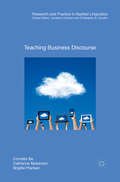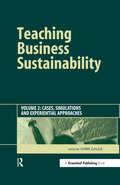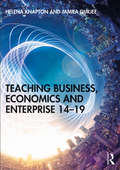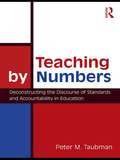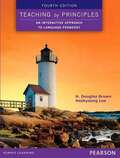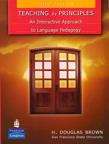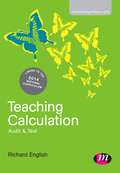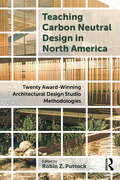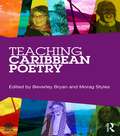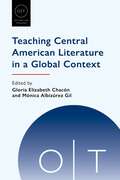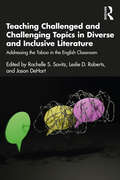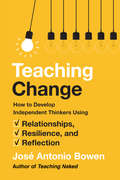- Table View
- List View
Teaching Business Concepts by the Use of Deliberate Metaphors
by Anqi GuoThis book discusses the underlying metaphors of some important business principles and terms and positive teaching effects from deliberately implanting those metaphors in business lessons. It introduces original metaphors creatively used in live webcast courses which introduce difficult economic concepts to netizens. The deliberate metaphor is considered to represent a new dimension of metaphor, the communicative dimension. The book explores the communicative effect of deliberate metaphors and proves its effectiveness in teaching difficult business concepts. This book explores different uses of deliberate metaphors designed to support the teaching of business concepts and discusses two teaching experiments done to explore their effectiveness. Results showed that a focused design using deliberate metaphors in the lectures improved test performance, while a scattered design using deliberate metaphors used in lectures significantly increased students’ interest in the lectures.
Teaching Business Discourse (Research And Practice In Applied Linguistics Ser.)
by Cornelia Ilie Catherine Nickerson Brigitte PlankenThis book presents research in business discourse and offers pedagogical approaches to teaching business discourse in both classroom and consultancy contexts that address the key issues of dealing with different types of learners, developing teaching materials and evaluation. Drawing on the authors’ extensive experience of researching business discourse from a variety of different perspectives including pragmatics, discourse analysis, rhetoric, and language for specific purposes, it demonstrates how these approaches may be applied to teaching. Each chapter includes a list of additional readings, together with a number of practical tasks designed to help readers apply the materials presented. Case studies are used throughout the book to illustrate the concepts, thus equipping readers with a set of research tools to extend their own understanding of how language and communication operate in business contexts, as well introducing them to a variety of research-based ideas that can be translated easily into a classroom setting. The book is cross-cultural in scope as it includes perspectives from a range of different contexts. It represents a significant advance in current literature and will provide a valuable resource for students and scholars of applied linguistics, business communication, and business discourse, in addition to teachers of Business English.
Teaching Business Education 14-19
by Martin Jephcote Ian AbbottWritten in association with the EBEA, this authoritative text provides a comprehensive and insightful study of current curriculum development and classroom practice with business education. Up-to-date, practical and covering the very latest issues, it presents: * Advice on planning courses and managing the curriculum * The latest developments in 14-19 * Guidance on the emerging work-related curriculum * A focus on key topics such as enterprise education, e-learning and citizenship * A teacher-reviewed annotated resource guide of text-based and web-based resources.
Teaching Business Sustainability Vol. 2: Cases, Simulations and Experiential Approaches
by Chris GaleaIf there is one area of business education that requires out-of-the-box, creative thinking it is sustainability. Business sustainability, because of its relative newness (and hence uncertainty), its dependence on interdisciplinary thinking, its need to work with different stakeholders and its non-traditional operating approaches, demands that we train our managers in wholly new ways. This need for new and non-traditional teaching approaches is reflected in this collection of unorthodox teaching pedagogies. The underlying philosophy behind them is that deep learning for sustainability needs ultimately to be experiential: that is, learning while doing rather than a passive absorption of facts and figures. While much of the underlying theory of sustainability may be taught using more traditional lecture and reading approaches, the implementation of true business sustainability requires students to experiment – to win and lose – while grappling with the myriad challenges and frustrations posed by sustainability: the same challenges and frustrations, one might add, that companies intent on implementing sustainability face on a daily basis in the world in which they operate. The aim is to create a learning environment where students themselves take control over their own learning. This book – a companion volume to Teaching Business Sustainability 1: From Theory to Practice (Greenleaf Publishing, 2004) – focuses on four main categories of experiential pedagogy: case studies, hands-on exercises, role-play simulations and active learning teaching exercises. It includes contributions from a range of experts in global sustainability education who provide their expertise with class-hardened teaching materials. Teaching Business Sustainability 2 will be an invaluable resource both for educators working in a wide range of academic disciplines, looking for inspiration and guidance on how to teach business sustainability, as well as for organisations looking to reinvigorate internal management education programmes to factor in corporate responsibility and sustainability issues.
Teaching Business, Economics and Enterprise 14-19
by Helena Knapton Jamila GurjeeThis book provides core knowledge and guidance for successful teaching in Business, Economics and Enterprise Education, and is based on the most up-to-date requirements. Written by experts with expertise in delivering business education in teacher training, further education, and secondary schools, it explores the nature of each subject in relation to the curriculum and offers subject-specific pedagogy to help develop teaching skills and confidence within the classroom. Including case studies and reflective questions in every chapter, the book covers the key topics across the subjects such as: Financial literacy Planning for the delivery of academic and vocational subjects The value of different qualifications and business and industry links Strategies for successful differentiation Assessment and pupil progression Teaching Business, Economics and Enterprise 14-19 is a vital resource for training or newly qualified teachers looking to deliver excellent teaching that will inspire their students and lead to successful learning.
Teaching By Numbers: Deconstructing the Discourse of Standards and Accountability in Education (Studies in Curriculum Theory Series)
by Peter Maas TaubmanOver the last decade the transformation in the field of education that is occurring under the twin banners of "standards" and "accountability" has materially affected every aspect of schooling, teaching, and teacher education in the United States. Teaching By Numbers, offers interdisciplinary ways to understand the educational reforms underway in urban education, teaching, and teacher education, and their impact on what it means to teach. Peter Taubman maps the totality of the transformation and takes into account the constellation of forces shaping it. Going further, he proposes an alternative vision of teacher education and argues why such a program would better address the concerns of well-intentioned educators who have surrendered to various reforms efforts. Illuminating and timely, this volume is essential reading for researchers, students, and professionals across the fields of urban education, curriculum theory, social foundations, educational policy, and teacher education.
Teaching By Principles: An Interactive Approach to Language Pedagogy
by H. Brown Heekyeong LeeTeaching by Principles is a widely acclaimed methodology test used in language teacher education programs around the world. In this fourth edition, Dr. H. Douglas Brown and Dr. Heekyeong Lee offer a comprehensive survey of practical language teaching options firmly anchored in current research on second language acquisition and pedagogy. Features of the Fourth Edition A comprehensive update on current issues, new research findings, and innovative classroom teaching techniques, with additional and reworked chapters to reflect this information A description and analysis of new foundational principles, including: agency, identity, languaculture, communities of practice, embodied cognition, and self-regulation Pre-reading organizers at the beginning of each chapter Frquent statistics and pedagogical "tips" in each chapter Numerous "classroom connections" to stimulate practical applications of concepts and principles End-of-chapter group activities, discussion topics, and suggested additional readings A glossary of technical terminology
Teaching By Principles: An Interactive Approach to Language Pedagogy
by H. Douglas BrownThis third edition of Teaching by Principles features: new chapters on course design, technology and critical pedagogy to reflect current trends and advances in methodology prereading organizers at the beginning of each chapter updated, expanded references treatment of other recent "hot topics" of interest: corpus linguistics form-focused instruction multiple intelligences nonnative English-speaking teachers autonomy willingness to communicate alternatives in assessment reflective teaching Also by H. Douglas Brown: Principles of Language Learning and Teaching, Fifth Edition Language Assessment: Principles and Classroom Practices Strategies for Success: A Practical Guide to Learning English.
Teaching Calculation: Audit and Test (Transforming Primary QTS Series)
by Mr Richard EnglishCan you demonstrate a clear understanding of primary mathematics? If you are training to be a primary school teacher you need to have, and demonstrate, a clear understanding of primary mathematics. This companion text to the popular Teaching Arithmetic in Primary Schools enables you to audit your knowledge, skills and understanding, making you more aware of the subject and the areas you need to develop further. It includes: self audits on all areas of calculations, supporting trainees to meet the Teachers' Standards clear links to classroom practice, linking theory with practice advice on next steps for further learning under each chapter If you're a trainee primary school teacher, this resource, along with its companion title will provide you with all the guidance and support needed to develop your Primary Maths subject knowledge and teaching skills. This book is part of the Transforming Primary QTS Series This series reflects the new creative way schools are beginning to teach, taking a fresh approach to supporting trainees as they work towards primary QTS. Titles provide fully up to date resources focused on teaching a more integrated and inclusive curriculum, and texts draw out meaningful and explicit cross curricular links.
Teaching Carbon Neutral Design in North America: Twenty Award-Winning Architectural Design Studio Methodologies
by Robin Z. PuttockThis book brings to light a diverse range of innovative architectural design studio methodologies formulated to educate future graduates to combat the climate crisis through carbon neutral design.Award-winning professors detail tried-and-tested studio methodologies, outlining their philosophical rationale, the role of precedent study, design concept and professional partnerships, the approach to analytics and software design development, required readings, assignment and student work examples, and anticipated future innovation. Chapters are grouped under varying focal points including community empowerment, bioclimatic response, performance analytics, design build, and urban scale, all adopting a holistic view of sustainable design that incorporates technical challenges as well as those of equity and social justice.This heterogeneous compilation of strategies encourages wide accessibility to and acceptance by studio professors, as well as administrators and faculty developing architecture curricula. This will, in turn, maximize the impact on curtailing carbon emissions resulting from the construction and operations of our built environment.
Teaching Caribbean Poetry (National Association for the Teaching of English (NATE))
by Morag Styles Beverley BryanTeaching Caribbean Poetry will inform and inspire readers with a love for, and understanding of, the dynamic world of Caribbean poetry. This unique volume sets out to enable secondary English teachers and their students to engage with a wide range of poetry, past and present; to understand how histories of the Caribbean underpin the poetry and relate to its interpretation; and to explore how Caribbean poetry connects with environmental issues. Written by literary experts with extensive classroom experience, this lively and accessible book is immersed in classroom practice, and examines: • popular aspects of Caribbean poetry, such as performance poetry; • different forms of Caribbean language; • the relationship between music and poetry; • new voices, as well as well-known and distinguished poets, including John Agard (winner of the Queen’s Medal for Poetry, 2012), Kamau Brathwaite, Lorna Goodison, Olive Senior and Derek Walcott; • the crucial themes within Caribbean poetry such as inequality, injustice, racism, ‘othering’, hybridity, diaspora and migration; • the place of Caribbean poetry on the GCSE/CSEC and CAPE syllabi, covering appropriate themes, poetic forms and poets for exam purposes. Throughout this absorbing book, the authors aim to combat the widespread ‘fear’ of teaching poetry, enabling teachers to teach it with confidence and enthusiasm and helping students to experience the rewards of listening to, reading, interpreting, performing and writing Caribbean poetry.
Teaching Central American Literature in a Global Context (Options for Teaching #58)
by Gloria Elizabeth Chacón Mónica Albizúrez GilCentral America has a long history as a site of cultural and political exchange, from Mayan and Nahua trade networks to the effects of Spanish imperialism, capitalism, and globalization. In Teaching Central American Literature in a Global Context, instructors will find practical, interdisciplinary, and innovative pedagogical approaches to the cultures of Central America that are adaptable to various fields of study. The essays map out classroom lessons that encourage students to relate writings and films to their own experience of global interconnectedness and to read critically the history that binds Central America to the United States, Mexico, and the Caribbean. In the context of debates about immigration and a growing Central American presence in the United States, this book provides vital resources about the region's cultural production and covers trends in Central American literary studies including Mayan and other Indigenous literatures, modernismo, Jewish and Afro-descendant literatures, nineteenth- and twentieth-century literature, and contemporary texts and films.This volume contains discussion of the following authors, filmmakers, and public figures: Humberto Ak'abal, María José Álvarez and Martha Clarissa Hernández, Dennis Ávila, Abner Benaim, Jayro Bustamante, Berta Cáceres, Isaac Esau Carrillo Can, Jennifer Cárcamo, Horacio Castellanos Moya, Quince Duncan, Jacinta Escudos, Regina José Galindo, Francisco Gavidia, Francisco Goldman, Enrique Gómez Carrillo, Gaspar Pedro González, Carlos "Cubena" Guillermo Wilson, Eduardo Halfon, Tatiana Huezo, Florence Jaugey, Hernán Jimenez, Óscar Martínez, Victor Montejo, Marisol Ceh Moo, Victor Perera, Archbishop Óscar Romero, José Coronel Urtecho, and Marcela Zamora.
Teaching Challenged and Challenging Topics in Diverse and Inclusive Literature: Addressing the Taboo in the English Classroom
by Jason DeHart Rachelle S. Savitz Leslie D. RobertsThis groundbreaking text provides practical, contextualized methods for teaching and discussing topics that are considered "taboo" in the classroom in ways that support students’ lived experiences. In times when teachers are scapegoated for adopting culturally sustaining teaching practices and are pressured to "whitewash" the curriculum, it becomes more challenging to create an environment where students and teachers can have conversations about complex, uncomfortable topics in the classroom. With contributions from scholars and K-12 teachers who have used young adult literature to engage with their students, chapters confront this issue and focus on themes such as multilingualism, culturally responsive teaching, dis/ability, racism, linguicism, and gender identity. Using approaches grounded in socioemotional learning, trauma-informed practices, and historical and racial literacy, this text explores the ways in which books with complicated themes can interact positively with students’ own lives and perspectives. Ideal for courses on ELA and literature instruction, this book provides a fresh set of perspectives and methods for approaching and engaging with difficult topics. As young adult literature that addresses difficult subjects is more liable to be considered "controversial" to teach, teachers will benefit from the additional guidance this volume provides, so that they can effectively reach the very students these themes address.
Teaching Change: How to Develop Independent Thinkers Using Relationships, Resilience, and Reflection
by José Antonio BowenThis pathbreaking book for educators shows that focusing on relationships, resilience, and reflection can better prepare graduates for the future.Learning something new—particularly something that might change your mind—is much more difficult than most teachers think. Because people think with their emotions and are influenced by their communities and social groups, humans tend to ignore new information unless it fits their existing worldview. Thus facts alone, even if discussed in detail, typically fail to open minds and create change. In a world in need of graduates who can adapt to new information and situations, we need to renew our educational commitment to producing flexible and independent thinkers. In Teaching Change, José Antonio Bowen argues that education needs to be redesigned to take into account how human thinking, behaviors, bias, and change really work. Drawing on new research, Bowen explores how we can create better conditions for learning that focus less on teachers and content and more on students and process. He also examines student psychology, history, assumptions, anxiety, and bias and advocates for education to focus on a new 3Rs—relationships, resilience, and reflection. Finally, he suggests explicit learning designs to foster the ability to think for yourself. The case for a liberal (by which Bowen means liberating) education has never been stronger, but, he says, it needs to be redesigned to achieve the goal of creating lifelong learners and citizens capable of divergent and independent thinking. With an expansive and powerful argument, Teaching Change combines elegant and gripping explanations of recent and wide-ranging research from biology, economics, education, and neuroscience with hundreds of practical suggestions for individual teachers.
Teaching Character Education through Literature: Awakening the Moral Imagination in Secondary Classrooms
by Karen BohlinThis book shows how secondary and post-secondary teachers can help students become more responsive to the ethical themes and questions that emerge from the narratives they study. It helps teachers to integrate character education into the classroom by focusing on a variety of ways of drawing instructive insights from fictional life narratives. The case studies and questions throughout are designed to awaken students' moral imagination and prompt ethical reflection on four protagonists' motivations, aspirations, and choices. The book is divided into two parts. The first provides a theoretical approach while the second features case studies to apply this approach to the study of four literary characters: Sydney Carton from Tale of Two Cities Jay Gatsby from The Great Gatsby Elizabeth Bennet from Pride and Prejudice Janie Crawford from Their Eyes Were Watching God The questions, ideas and approaches used in these case studies can also be applied to protagonists from other narrative works in the curriculum.
Teaching Character and Virtue in Schools (Citizenship, Character and Values Education)
by Kristján Kristjánsson James Arthur Tom Harrison Daniel Wright Wouter SanderseTeaching Character and Virtue in Schools addresses the contemporary issues of quantification and measurement in educational settings. The authors draw on the research of the Jubilee Centre at the University of Birmingham in order to investigate the concern that the conventional wisdom, sound judgement and professional discretion of teachers is being diminished and control mistakenly given over to administrators, policymakers and inspectors which in turn is negatively effecting pupils’ character development. The books calls for subject competence to be complemented by practical wisdom and good character in teaching staff. It posits that the constituent virtues of good character can be learned and taught, that education is an intrinsically moral enterprise and that character education should be intentional, organised and reflective. The book draws on the Jubilee Centre’s expertise in support of its claims and successfully integrates the fields of educational studies, psychology, sociology, philosophy and theology in its examination of contemporary educational practices and their wider effect on society as a whole. It offers sample lessons as well as a framework for character education in schools. The book encourages the view that character education is about helping students grasp what is ethically important and how to act for the right reasons so that they can become more autonomous and reflective individuals within the framework of a democratic society. Particularly interested readers will be educational leaders, teachers, those undertaking research in the field of education as well as policy analysts with a keen interest in developing the character and good sense of learners today.
Teaching Character in the Primary Classroom
by Ian Morris John Ryan Tom Harrison"Teaching Character in the Primary Classroom provides an excellent and very accessible overview of the emerging field of character education. It covers, in detail, the theory of character education as well as advice and guidance about how this should be applied in practice in primary schools." Professor James Arthur, University of Birmingham Character matters. As more and more schools are choosing to teach Character Education, trainee and beginning teachers need to know more. What is Character Education? Can it really be 'taught'? How does children's learning benefit from discussions around character in the classroom? How do I teach it? What does good teaching of Character Education look like in the classroom? Teaching Character Education in Primary schools tackles these questions, and many more. This is a practical guide to why and how we can teach character in primary schools. It begins by exploring why character matters and considers what 'character' is and (importantly) what it is not. It goes on to discuss the place for teaching character in primary education and includes practical guidance on how it can be taught. The text also looks at character beyond the classroom, how parents and the wider community can be included in the teaching of character and how outdoor learning and education can contribute. This book is written for all those who are new to teaching character.
Teaching Character in the Primary Classroom
by Ian Morris John Ryan Tom Harrison"Teaching Character in the Primary Classroom provides an excellent and very accessible overview of the emerging field of character education. It covers, in detail, the theory of character education as well as advice and guidance about how this should be applied in practice in primary schools." Professor James Arthur, University of Birmingham Character matters. As more and more schools are choosing to teach Character Education, trainee and beginning teachers need to know more. What is Character Education? Can it really be ′taught′? How does children′s learning benefit from discussions around character in the classroom? How do I teach it? What does good teaching of Character Education look like in the classroom? Teaching Character Education in Primary schools tackles these questions, and many more. This is a practical guide to why and how we can teach character in primary schools. It begins by exploring why character matters and considers what ′character′ is and (importantly) what it is not. It goes on to discuss the place for teaching character in primary education and includes practical guidance on how it can be taught. The text also looks at character beyond the classroom, how parents and the wider community can be included in the teaching of character and how outdoor learning and education can contribute. This book is written for all those who are new to teaching character.
Teaching Children 3-11: A Student's Guide
by Anne Cockburn Graham HandscombFocusing on the major topics underpinning professional studies strands in primary and early years teacher education, Teaching Children Three-Eleven provides indispensable coverage of vital practical and conceptual issues that support good teaching practice. This Third Edition of the popular textbook has been carefully revised, following detailed lecturer feedback, to meet the evolving needs of students training to teach across the three to eleven age range. Featuring four new chapters on curriculum development, cross-curricular teaching, diversity and inclusion, and communication in the classroom, and engaging with the growing need for Master's-level study in teacher education, the new edition offers a balanced contemporary overview of modern teaching practice in an engaging and accessible manner. This is essential reading for all students on primary and early years initial teacher education courses including undergraduate (BEd, BA with QTS), postgraduate (PGCE, SCITT), and employment-based routes into teaching. It will also be invaluable for those starting out on their professional careers. Anne Cockburn is Professor of Early Years Education at the University of East Anglia Graham Handscomb is Senior Manager in Strategic Development, for School Improvement and Early Years at Essex County Council
Teaching Children Bible Basics: 34 Lessons for Helping Children Learn to Use the Bible
by Barbara BruceTeaching Children Bible Basics is a book of 34 Old and New Testament lessons that helps children ages 8–10 learn how to use the Bible. The lessons and activities are designed to teach children how the Bible came to be, how to use this important book, about the Torah, and about the important stories of the Hebrew and Christian Testaments. Key Features: Features 16 Old Testament and 20 New Testament lessons; Provides 30- to 45-minute experiential lessons that teach children how to use the Bible; Each lesson accommodates the needs of various learning styles; Each lesson highlights a specific desired result (for example, students will discover and retell the creation story day by day); Each lesson includes a lesson focus, a Scripture text, a section listing materials needed, various learning activities, discussion questions related to the Bible topics being “discovered,” and a closing prayer. Key Benefits: Teachers will be enabled to teach children aged 8–10 basic Bible skills through interactive Bible lessons that stimulate creativity and critical thinking; Teachers will find practical help and guidance in how children can gain a working knowledge of the structure of the Bible, the organization of the books of the Bible, and the significance of the Bible to Christians; Can be used with any Bible translation.
Teaching Children Compassionately: How Students and Teachers Can Succeed With Mutual Understanding
by Marshall B. RosenbergThe tenets of Nonviolent Communication are applied to a variety of settings in these booklets on how to resolve conflict peacefully.
Teaching Children English as an Additional Language: A Programme for 7-12 Year Olds
by Caroline ScottHere is a typical classroom scenario: out of the thirty children, two-thirds speak a different language at home and only speak English at school. Even though many pupils’ English skills are almost non-existent, teachers are expected to provide the national curriculum for every child in the class. Teaching Children English as an Additional Language solves this problem with a ten-week teaching programme of units and lesson activities for children aged seven–eleven (Key Stage 2) new to English. It will help these children learn some very basic English sentences, questions and vocabulary, to get them through regular day-to-day routines more easily. By offering a flexible step by step approach this book helps EAL teachers to: identify learners’ individual needs teach grammar and vocabulary support teaching through speaking and listening assess pupils to inform future planning The programme also contains emergency lessons to support learners in the first three days, cross curricular links, ways of using a home-school learning book and an opportunity for the child to make a booklet about themselves. It fosters the child’s home language, incorporates different learning styles as well as including a wealth of carefully tailored, themed resources. The programme is complete with activities, resources and assessment materials and helpful tips on how to develop a successful EAL department.
Teaching Children Who Are Hard to Reach: Relationship-Driven Classroom Practice
by Torey Hayden Michael J. MarloweCreate lasting, positive change for our most troubled students! How do you move beyond traditional classroom management to create a learning environment that engages our hardest-to-reach students—students who may be struggling due to emotional disturbances, disabilities, or environmental circumstances? Marlowe and Hayden have the answer: through a relationship-driven classroom. With the help of their book, you will: Gain a meaningful understanding of troubled students and how to reach and teach them Learn how to change inappropriate behavior rather than just control it Develop the essential skills for building successful classroom relationships Become more reflective about teaching and learning with challenging children
Teaching Children Who are Deafblind: Contact Communication and Learning
by Catherine Clark Stuart Aitken Marianna Buultjens Jane T. Eyre Laura PeaseFirst published in 2000. Routledge is an imprint of Taylor & Francis, an informa company.
Teaching Children With Autism in the General Classroom
by Vicky G. Spencer Cynthia G. SimpsonSuccessful strategies for educating students with autism in the regular classroom. Recent special education legislation has led to a rise in inclusion classrooms, where students with special needs, including autism spectrum disorders, are taught alongside their nondisabled peers. Teaching Children with Autism in the General Classroom provides an introduction to inclusionary practices that serve children with autism, giving teachers the practical advice they need to ensure each student receives the quality education he or she deserves. Promoting field-tested strategies and techniques, this book offers teachers sound advice for creating a classroom environment conducive to learning success for children with autism spectrum disorders. The easy-to-use tips and tools included also aide teachers in organizing and managing their classrooms to maximize instruction for students of all ability levels. Detailed resource guides and concise overviews of special education legislation also are provided to give general education teachers a solid background of knowledge about autism and the needs of students with the disorder.

